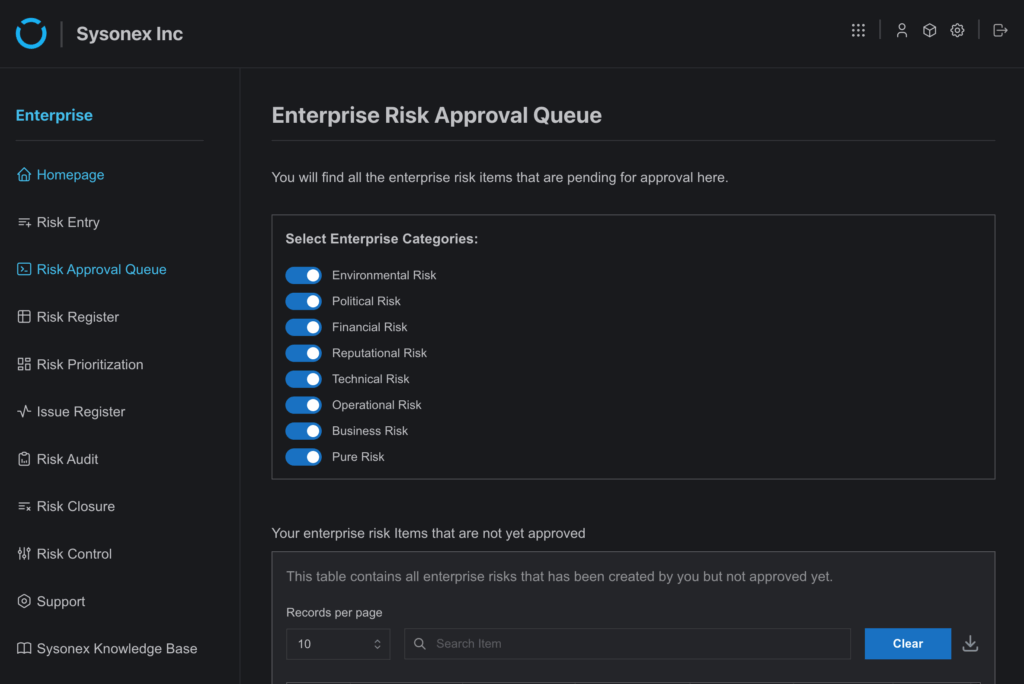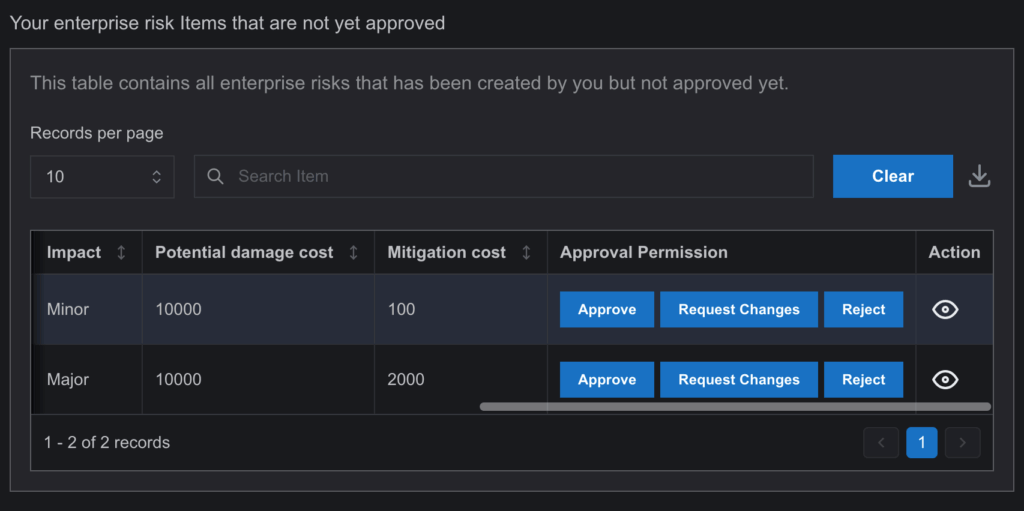-
FAQs
-
Sysrisk User Manual
-
- Step-by-Step Guide to SysRisk Purchasing Process
- Team or Enterprise License Purchase: Login and Profile Setting Process
- Password Management Process
- Company Profile in SysRisk
- User Creation and Role Assignment in SysRisk
- Customization and Dashboard Configuration
- Homepage Overview
- SysRisk Activity Logs
- Category Management for ERM
- Risk Approval Overview1
- Risk Entry Page for ERM
- Risk Entry Page for PRM
- Creating AI-Generated Risk Entries in SysRisk
- Risk Register Risk Prioritization Page Overview
- Risk Creation, Edit and Approval Process in SysRisk
- Risk Closure Process in SysRisk
- SysRisk Auditing Record Maintenance
- Risk Notification Settings
- Show Remaining Articles (3) Collapse Articles
-
-
Risk Management
-
- Control Risk
- ERM
- Inherent Risk
- Qualitative Risk Analysis
- Quantitative Risk Analysis
- Residual Risk
- Risk Acceptance
- Risk Acceptance Criteria
- Risk Aggregation
- Risk Analysis
- Risk Analysis Methods
- Risk Analytics
- Risk Appetite
- Risk Appetite Framework
- Risk Appetite Statement
- Risk Assessment
- Risk Assessment Matrix
- Risk Assessment Process
- Risk Attribution
- Risk Avoidance
- Risk Bearing Capacity
- Risk Benchmarking
- Risk Capacity
- Risk Capital
- Risk Clustering
- Risk Communication
- Risk Communication Plan
- Risk Concentration
- Risk Contingency
- Risk Contingency Plan
- Risk Control
- Risk Convergence
- Risk Criteria
- Risk Culture
- Risk Dashboard
- Risk Dependency
- Risk Diversification
- Risk Escalation
- Risk Escalation Path
- Risk Evaluation
- Risk Exposure
- Risk Financing
- Risk Framework
- Risk Governance
- Risk Heat Map
- Risk Horizon
- Risk Identification
- Risk Indicator
- Risk Intelligence
- Risk Interdependency
- Risk Inventory
- Risk Landscape
- Risk Management(RM)
- Risk Management Dashboard
- Risk Management Framework
- Risk Management Maturity
- Risk Management Plan
- Risk Management Policy
- Risk Mapping
- Risk Matrix
- Risk Maturity
- Risk Mitigation
- Risk Mitigation Plan
- Risk Mitigation Strategy
- Risk Model
- Risk Monitoring
- Risk Optimization
- Risk Owner
- Risk Ownership
- Risk Policy
- Risk Portfolio
- Risk Prioritization
- Risk Profile
- Risk Quantification
- Risk Reduction
- Risk Register
- Risk Register Update
- Risk Reporting
- Risk Resilience
- Risk Response
- Risk Response Plan
- Risk Review
- Risk Review Process
- Risk Scenario
- Risk Scenario Analysis
- Risk Scenario Planning
- Risk Scoring
- Risk Sensing
- Risk Sharing
- Risk Strategy
- Risk Taxonomy
- Risk Threshold
- Risk Tolerance
- Risk Tolerance Level
- Risk Transfer
- Risk Transparency
- Risk-Adjusted Return
- Show Remaining Articles (82) Collapse Articles
-
- Business Continuity Risk
- Capital Risk
- Competition Risk
- Compliance Risk
- Counterparty Risk
- Credit Risk
- Credit Spread Risk
- Currency Risk
- Cybersecurity Risk
- Deflation Risk
- Environmental Risk
- Ethical Risk
- Event Risk
- Financial Risk
- Foreign Exchange Risk
- Fraud Risk
- Geopolitical Risk
- Health and Safety Risk
- Human Capital Risk
- Inflation Risk
- Infrastructure Risk
- Innovation Risk
- Insurance Risk
- Intellectual Property Risk
- Interest Rate Risk
- Legal Risk
- Liquidity Risk
- Market Risk
- Model Risk
- Natural Disaster Risk
- Operational Risk
- Outsourcing Risk
- Political Risk
- Product Liability Risk
- Project Risk
- Regulatory Change Risk
- Regulatory Risk
- Reputation Risk
- Reputational Risk
- Resource Risk
- Sovereign Risk
- Strategic Alliance Risk
- Strategic Risk
- Supply Chain Risk
- Sustainability Risk
- Systemic Risk
- Technological Risk
- Technology Risk
- Show Remaining Articles (33) Collapse Articles
-
The Risk Approval Queue is a crucial component for managing risk governance within the system. It allows authorized users to review, approve, or reject risk entries submitted by risk creators. This feature streamlines the risk approval process by centralizing all pending risk approvals in one interface, ensuring that only authorized personnel can manage and approve the risks.

Key Functionalities of the Risk Approval Queue
Category/Project/Ftamewor Filtering
Users can filter the risks based on the category they are associated with, allowing them to view only relevant risks pending approval.

Approval Permissions
Only the following users can access the Risk Approval Queue:
- Product Admins: Admins assigned to both user and admin group of a module, have full approval and rejection rights.
- Root Admins: Administrator with authority over all modules can approve any risk across all products.
- Risk Owners: Users who have been designated as the owner of a specific risk also can approve or reject their assigned risks.
Risk Fields in the Queue
The Risk Approval Queue presents essential details for each risk, including:
- Title: The title of the risk item.
- Risk Owner: The individual assigned as the owner of the risk.
- Assigned To: The user responsible for managing the risk.
- Likelihood: The assessed likelihood of the risk occurring.
- Impact Severity: The potential damage the risk could cause.
- Action Options: A set of actions that the authorized user can take (view, approve, reject, or request changes).
Approval Process
- Detailed View: Users can click on a risk item to view all its details, including the title, description, risk owner, assignee, likelihood, impact severity, potential damage, and mitigation cost.
- Approval Action: Authorized users (Project Admins, Root Admins, or Risk Owners) can approve a risk directly from the queue. Once a risk is approved:
The risk status is updated to “Approved.”
The risk continues to the next step in the workflow, if applicable.
Notifications are automatically sent to the risk owner, assignee, and risk monitors, confirming the approval.

Reject Risk
- Rejection Action: Users with approval authority can also reject a risk. Reasons for rejection can be added as comments. Once rejected:
The risk status changes to “Rejected.”
The risk owner, assignee, and monitors are notified of the rejection and any reasons provided.
Request Changes
- Comment and Request Changes: Instead of outright rejection, approvers can request modifications to the risk item. They can:
- Leave comments detailing the changes required.
- Notify the risk owner and assignee, who can then update the risk and resubmit it for approval.
Notifications and Workflow Integration
- Email Notifications: Once a risk is approved, rejected, or sent back for changes, the system automatically sends notifications to:
- The risk owner.
- The assignee.
- Risk monitors.
- SLA Notifications: All actions related to risk approvals, rejections, and comments are integrated with the Risk SLA Notification system, ensuring that notifications and deadlines are aligned with project timelines and service level agreements.
